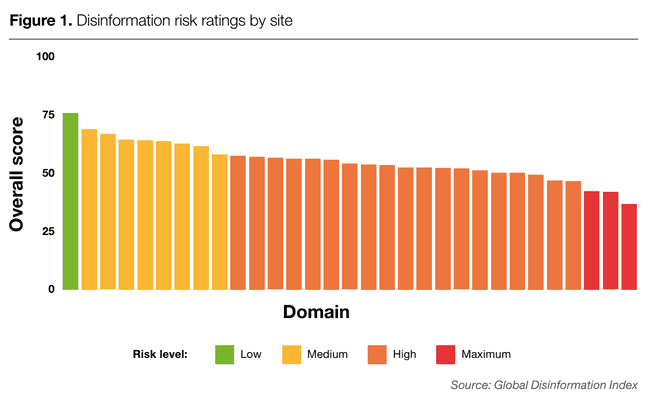June 7, 2023
Disinformation Risk Assessment: The Online News Market in Türkiye
Almost two-thirds of the sampled domains presented a high or maximum level of disinformation risk.
Note: this post references a methodology specific to Media Market Reviews published by GDI.
The Global Disinformation Index (GDI) is pleased to present a new report assessing the disinformation risks in the Turkish media market. This report is the result of research led by GDI, in collaboration with Freedom Research Association, conducted between September 2022 and February 2023.
As the media landscape increasingly shifts from traditional outlets to the online world, the risk of circulating and being exposed to disinformation has increased across the globe. Though disinformation has long been a key issue for media organisations, the internet has allowed harmful, disinforming narratives to spread further and faster than ever before. This paradigm shift makes it essential for news outlets, consumers and advertisers alike to understand their disinformation risk. GDI’s risk rating methodology provides key insights for all stakeholders to mitigate their disinformation risk and feel confident in the information they fund, produce and consume.
The following report presents our findings regarding disinformation risk in Türkiye’s media market, based on a study of 31 news domains. The sample was defined based on the sites’ reach (using each site’s Alexa rankings, Facebook followers, and Twitter followers), relevance and the ability to gather complete data for the site.
Overview
Türkiye is home to a vast and influential media market that has rapidly adapted to the rise of the internet in the past two decades. With an internet penetration rate of about 82 percent in 2022 - a nearly six-point increase from the year before - and a meteoric rise in the country’s advertising market, this dynamic ecosystem shows no signs of slowing down as readers transition to digital consumption.
Like many other countries, traditional news dominated the Turkish media market for many decades and has only recently been replaced by digital options such as social media and online newspapers as the preferred primary source of news consumption among the population. This shift has coincided with declining public trust in media institutions and a sharp rise in the number of citizens who self-report frequent exposure to fake news. These factors all follow global trends, but when combined, place the media market in a vulnerable position when it comes to disinformation risk.
Challenges specific to this market also present key risk factors for media organisations, advertisers and readers alike. The swift migration to digital media has placed financial pressure on outlets to rapidly produce information to drive higher engagement which can make outlets more susceptible to circulating disinformation, intentionally or not. Additionally, highly concentrated media ownership and deep political polarisation heighten the market’s vulnerability.
Findings
The findings for the Turkish news domains in this sample show that nine sites were classified as low- or medium-risk, 19 as high-risk, and three sites as maximum-risk. Only one site in the study was classified as low-risk, and no sites achieved minimum-risk status.
The overall average score for domains in Türkiye was 55 out of 100, with 0 indicating no risk and 100 indicating maximum risk. This average score translates to a moderate risk level for the overall media market. Many of the sampled sites had measures to mitigate disinformation risk in regards to their content, but a comparatively poor performance in operational risk management contributed to a lower average score.
The vast majority of sites in the study performed relatively well in our Content pillar, which means that they generally avoided sensationalism and did not establish in-group and out-group dynamics in their news coverage. However, usage of sensational language and negative targeting among some outlets undercut higher scores on other indicators. Additionally, many sites performed poorly on identifying sources and including bylines, bringing the average score in this pillar down.
The Operations pillar presented the biggest source of disinformation risk for sites in this sample, with domains scoring an average of 39 across all indicators in this category. Largely due to legal requirements, nearly all sites achieved high scores in regards to comment policies and ownership disclosure. However, the domains performed significantly worse on other operational indicators such as publishing accuracy policies and editorial guidelines, contributing the lion’s share of the risk in this pillar.
Conclusion
These findings show that the overall disinformation risk in the Turkish media market is moderate, but the majority of risk comes from a lack of transparency regarding journalistic policies and practices on the operational side rather than from content. This means that, luckily, many domains can significantly improve their scores and lower their disinformation risk relatively easily by addressing these operational shortcomings and being more transparent about their policies and funding.
Relatively high Content scores show that despite political polarisation, Turkish media is generally adhering to risk-mitigation standards to avoid disinforming content. On the other hand, low Operations scores threaten to undermine these protections if they go unaddressed.
Though the sites in this study vary in risk classifications, all of the domains are vulnerable to disinformation risk. If sites take the following action items, they can greatly reduce their risk level and assure readers, funders and advertisers alike that they are making strides to guard against disinformation:
- Establish and publish pre-publication fact-checking policies on their website
- Make clear, publicly accessible guidelines for content production
- Include more transparency on financial structure and funding sources
- Encourage and reward best practices of journalistic standards and procedures such as using multiple and diverse sources, ensuring accurate attribution and publishing authorship information.
Read the full report for GDI’s full analysis and learn more about what Turkish newsrooms can do to minimise the risk of exposing their readers to disinformation.
Related Content

The Online News Market in Germany
The Global Disinformation Index (GDI) has produced an overview of disinformation risk ratings for some of the top used media sites in Germany.

The Online News Market in Georgia
Overview of disinformation risk ratings for some of the top used media sites in Georgia.

The Online News Market in The UK
The report provides an in-depth breakdown of the disinformation risks recorded across the UK media market, based on findings for 30 of some of the top news sites in the country.
